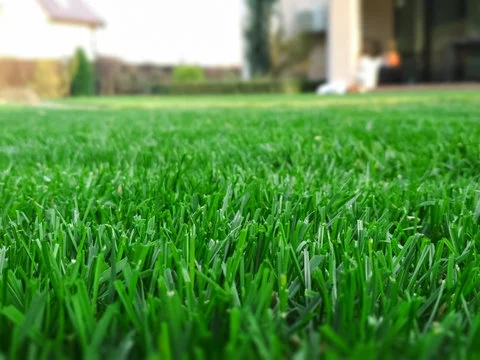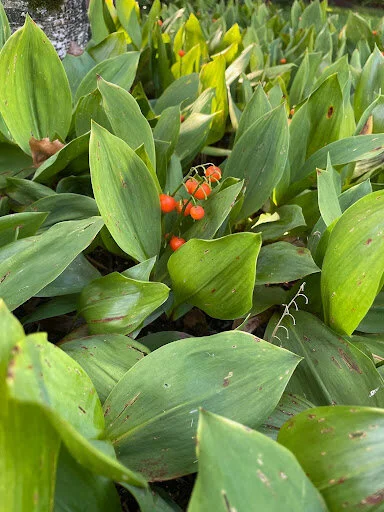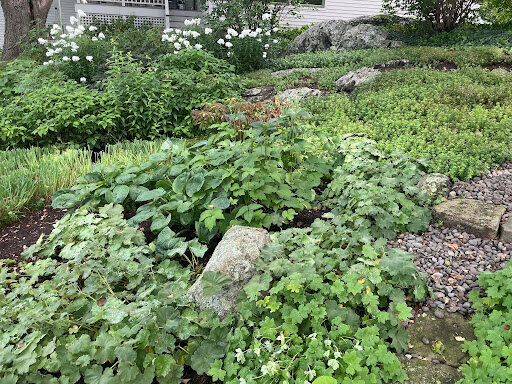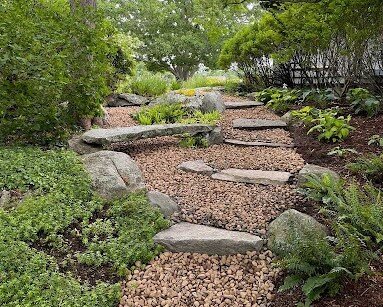Living Mulch and Groundcovers: Low-Maintenance Alternatives to Lawns and Formal Garden Beds
Have you ever thought about why it takes so much work to establish and maintain a gorgeous, lush green lawn? First, let’s define a monoculture: “[The] growth of a population of a single kind of organism grown on land in a monoculture”. The nature of the lawns we desire being a uniform, consistent swath of green often means that one species of grass dominates the area. Sometimes a blend will be used, but that does not add a significant amount of diversity. If you look around the natural world, very few monocultures exist.
The randomness of nature acts as a defense mechanism for the survival of many species. If you were a plant, you’d want to have some variety of plant-neighbors in your area that are resistant to diseases and critters that could cause you harm. These neighbors would slow the spread of those diseases and deter the critters, and you could be returning the favor for the other plants in your area!
A typical monoculture lawn. (Stock Photo)
Other Benefits Of Plant Diversity…
Diversity of plants also helps to keep the soil nutrients balanced. We need to put a lot of work into maintaining the soil conditions (balanced nutrients and proper soil structure) in lawns to keep the grass green and full. If you’re feeling like getting nerdy, and are interested in learning more about how monocultures can affect soil quality, plant growth, food-security and the economic system, it’s worth looking into the Dust Bowl of the 1930s. It is a well-documented event that affected all of North America...there’s a Ken Burns documentary, a quick 4-page article, and a novel (The Grapes Of Wrath - this has been converted into this 1940 film) that shed light on the topic. Ok, yes, that was a tangent, let’s get back to the landscaping world...
How Does Traditional Lawn Management Affect The Environment?
We humans have figured out how to maintain monocultures in our lawns, agricultural crops, and nursery fields, but at what costs? To keep a lawn looking “perfect” there are a lot of inputs needed throughout the year and every year. Chemical fertilizers, pesticides, water and irrigation, soil amendments, mowing labor, fuel for the mowers, and the emissions in the air we breathe. We “juice” up our lawns just to cut them back over and over again. This article is not to discourage lawn use or installation, but to consider the alternatives available if anyone is contemplating reducing the cost of their landscape maintenance or wanting to reduce their carbon footprint. Have any of you installed irrigation systems only to have a water ban in your town? We experienced a long-lasting drought in 2020 and climate change is threatening to increase the frequency and/or intensity of droughts in the future. Check out the data from NOAA in the embedded graphic below or view the full website).
PSST! We covered water conservation in our July Blog, which includes low-maintenance plant recommendations. Check it out!
So what is a living mulch anyway?
Reducing the surface area of high-maintenance landscape elements like manicured lawns or mulch beds on your property with low-maintenance lawn alternatives can save you headaches and money. Once established, a living mulch will replace the weeds that like to fill in empty spaces!
Living mulch can be a creeping juniper that spreads along the ground and covers the soil, holding it in place. It can be a carpet of Liriope, Bearberry, Thyme, Creeping Sedum or a patch of Lily Of The Valley. These groups of plants cool the ground, retain moisture, shade out weeds, and slow soil erosion. They promote biodiversity, providing habitat and sustenance for living creatures with berries, seeds, nectar, and other edibles. These areas require no mowing, no bark mulching, and little irrigation and weeding once established.
Lily of The Valley is a hardy groundcover, tolerant of many landscape conditions and gives off a delicate floral scent when it is blooming in the springtime.
What Does It Look Like Once Established?
Here is an example of an established low-maintenance groundcover garden at one of our maintenance properties. Leigh comments, “This particular garden was not installed by us, I’ve been admiring it for years and would love to create one for someone. It is composed of Lowbush Blueberry, Sedum ‘Angelina’, Geranium, Lady’s Mantle, and Hosta. It is accented with a river rock path and stone bench. This garden is simple, elegant, and clean with a calming effect that nourishes the soul.”
How About Freshly Installed?
Another example of an alternative yard space is this newly installed groundcover garden. The clients were having trouble trying to grow grass so we removed it and planted Irish Moss, Creeping Thyme, Chocolate Chip Bugleweed (Bugleweed is also known as Ajuga) and two different kinds of Creeping Sedum. So far, this garden is doing well. We will keep the straw mulch down until next spring to keep the weeds at bay and insulate the ground around the perennials through the winter.
Don’t get us wrong, lawns are beautiful and have a purpose. They provide us with outdoor living spaces and keep the soil from eroding. The question is, do we need so much of it?
Installed in Spring of 2021
So What’s Next?
You Say “I’m interested”, We Say “Let’s Meet!”
If you are having trouble managing, attaining or sustaining large lawns and/or gardens, establishing some groundcovers plantings as a living mulch might be the answer! We would be happy to meet with you, contact us here.
See you next month!
This article was written by Leigh Lessard, Director of Landscape Maintenance with editing and publishing help from Daisy Chinburg, Landscape Designer.
To schedule a consultation on water conservation at your property, please email Leigh Lessard at leigh@sitestructureslandscape.com or call Site Structures at (207) 438-9995.
And, as always, for general inquiries all are welcome to drop us a line at 207-438-9995 or email info@sitestructureslandscape.com.





